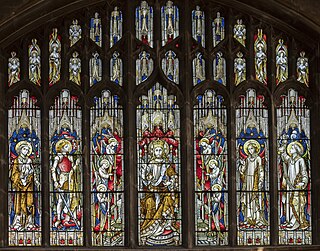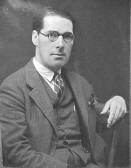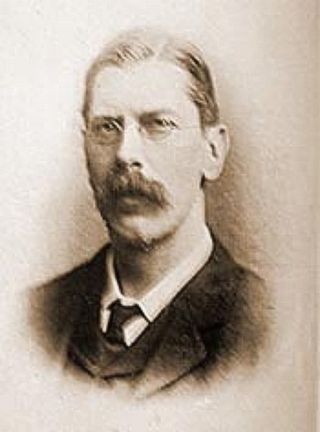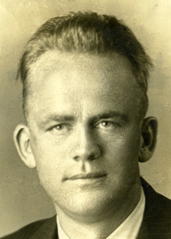History
Early years
In 1834 James Powell (1774–1840), then a 60-year-old London wine merchant and entrepreneur of the same family as the founder of the Scout movement, Robert Baden-Powell, 1st Baron Baden-Powell, [1] purchased the Whitefriars Glass Company, a small glassworks off Fleet Street in London, believed to have been established in 1680. Powell, and his sons Arthur and Nathanael, were newcomers to glass making, but soon acquired the necessary expertise. They experimented and developed new techniques, devoting a large part of their production to the creating of church stained glass windows. The firm acquired a large number of patents for their new ideas and became world leaders in their field, business being boosted by the building of hundreds of new churches during the Victorian era. While Powell manufactured stained glass windows, it also provided glass to other stained glass firms.
A major product of the factory was decorative quarry glass which was mass-produced by moulding and printing, rather than hand-cutting and painting. This product could be used in church windows as a cheap substitute for stained glass. It was often installed in new churches, to be later replaced by pictorial windows. Most of this quarry glass was clear, printed in black and detailed in bright yellow silver stain . Occasionally the quarries were produced in red, blue or pink glass, but these are rare. Surprisingly few entire windows of Powell quarries are to be seen in English churches, although they survive in little-seen locations such as vestries, ringing chambers and behind pipe organs. St Philip's Church, Sydney, retains a full set of Powell quarry windows, as does St Matthew's Church in Surbiton which was built in 1875 – a relatively late date for quarry windows, which may account for their survival. Powell also produced many windows in which pictorial mandorlas or roundels are set against a background of quarries.[ citation needed ]
Later Victorian period
During the latter part of the nineteenth century, the firm formed a close association with leading architects and designers such as T. G. Jackson, Edward Burne-Jones, William De Morgan and James Doyle. Whitefriars produced the glass that Philip Webb used in his designs for William Morris. The firm's production diversified in the 1850s to include domestic table glass after supplying the glassware for William Morris's Red House.

In 1875 Harry James Powell, grandson of the founder and an Oxford graduate in chemistry, joined the business. His training, which led to more scientific production and innovations such as previously unattainable colours and heat-resistant glass, for applications in science and industry, like X-ray tubes and light bulbs.
New production lines such as opalescent glass proved to be extremely successful. The firm took part in major exhibitions around the world. Designs were copied from historical Venetian and Roman glass found in European museums and art galleries. Nathanael Powell's eldest surviving son, Harry, an admirer of Ruskin, delivered numerous lectures on glass manufacture.
Between the wars
The firm's name was changed to Powell & Sons (Whitefriars) Ltd in 1919 and the growth in business demanded new premises. In 1923 the new factory was opened in Wealdstone. Despite a flourishing business, the great expense of the new factory scuttled plans to construct a village to house the workers in a style fashionable during the Arts and Crafts movement.

In the years between World War I and World War II, business and the financial situation were much improved. Glassware trended to the colourful and heavy, and optic moulding and wheel engraving played a major part in bringing the Art Deco style to the middle and upper classes.
It was during this period that James Humphries Hogan (1883–1948), a designer with the firm, had the most impact on Powell & Sons. Hogan was apprenticed to the Powell & Sons firm at the age of fifteen, and it was the sole employer in his career. He designed extremely important windows for many cathedrals in England, and the finest of these are the two windows in the great central space of Liverpool Cathedral and the windows in St. Thomas Church, Fifth Avenue, New York City, which were fabricated between the World Wars. His influence in the area of stained glass is legendary, and his designs for tableware and serviceware, including the stemmed glassware he created specifically for the British Embassies over all the world, are without peer. He rose in the company, becoming Chief Designer in 1913, Art Director in 1928, Managing Director in 1933, and finally Chairman of the firm in 1946. In addition, Hogan traveled throughout the United States, as primary sales agent for the Powell & Sons firm. From the period between 1926 and 1928, he produced a ten-fold increase in the Powell & Sons stained glass sales in America. Unquestionably, he was a workaholic, and literally worked himself to death: returning from a long sales trip to the United States in late December 1947, he collapsed on 3 January 1948, and slipped in a coma-like state. He died on 12 January 1948, without ever regaining consciousness. [2]
In the 1930s the firm started production of millefiori paperweights, characterised by shallow domes and wide bases. This period of prosperity ended with World War II. Glass manufacture was restricted to that aiding the war effort. By the end of the war, the company was struggling to survive.
Postwar

The Festival of Britain of 1951 helped the British economy to recover. Whitefriars was selected as an outstanding example of modern British industry. The following years saw austere and functional Scandinavian design sweeping Europe, and dominating stock purchases by major outlets such as Selfridges and Fortnum & Mason. The arrival of glass bricks which were cheap, thick slabs of coloured glass set in concrete bricks, dispensed with the need for expensive stained glass in new churches. [3]
In 1952 the company was acquired by GH Zeal Limited who in 1962 changed the company's name back to Whitefriars Glass Ltd, specializing in freeform domestic glassware. In 1981 Caithness Glass purchased a 25 year license to use the Whitefriars name for its paperweights. [4]
Former art student of the Royal College of Art, where he obtained a first class degree, Geoffrey Baxter was employed as a designer in 1954 by Chief Designer, William Wilson. [5] Baxter introduced a range of textured vases in 1967.[ citation needed ]
Among the large range of new designs were included the iconic 'drunken bricklayer' vases, 'TV' vases, ' bark' vases, 'coffin' vases, and 'banjo' vases. Nicknames for other designs in the textured range include nailhead, mobile phone, bamboo, basket weave, shoulder, cello, cucumber, nuts & bolts, totem pole, sunburst, pyramid, volcano, hooped, onion, double diamond, zig zag, pinecone, bottle, traffic light, stitched cube, Greek key, mallet, chessboard, Aztec, nipple, tulip, haemorrhoid, pot belly, tapered, and chalice vases.[ citation needed ]
Baxter used found objects including bark and nails to produce moulds for soda-lime glass. The bark effect vases and others in the textured range introduced colours including willow, cinnamon and indigo, and then additional colours such as tangerine, meadow green, aubergine, pewter, ruby, lilac, sage green, aqua, gold, flint (clear) and kingfisher blue.[ citation needed ]
The coloured glass was encased in clear glass. Baxter stayed with Whitefriars Glass until production ceased in 1980. [6] The high labour costs of handmade glass and late 1970s economic problems in the UK had made Whitefriars uncompetitive. The factory site was bulldozed. Baxter died on 22 August 1995.[ citation needed ]
Dalle de verre and Pierre Fourmaintraux
Whitefriars was a leading producer of dalle de verre glass in Britain. Pierre Fourmaintraux brought the technique to the country from France[ citation needed ] and while at Whitefriars designed, produced and taught the technique. He is credited with teaching leading dalle de verre artist Dom Charles Norris.
Fourmaintraux became James Powell & Sons (later Whitefriars Glass) chief designer of slab glass and abstract windows from 1956. His first dalle de verre piece for the UK was said to be two small windows for St Peter's Reigate. Whitefriars identified their glass with a small image of a hooded friar, usually in a bottom corner of the window. Fourmaintraux identified his own glass by adding his initials PF near the friar. [7]















